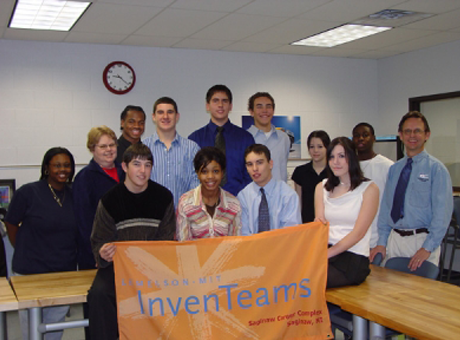Saginaw Career Complex InvenTeam
Athletic fields require a great deal of manual upkeep, including reapplication of painted boundary lines. There are some machines to aid humans with this work, but these machines are expensive and require manual operation. The Saginaw Career Complex InvenTeam devised an autonomous robot to stripe new athletic fields or retrace existing ones. The team's proposed robot would line a new field in two-thirds of the time it takes to do it manually, and retrace an old field in one-third of the time it takes to do it manually. The field striper is equipped with a combination of sensor feedback, infrared sensors, and digital compasses. The heliotropic solar panel can output 14-18 volts back into the energy storage system and expand the range of the robot. The robot uses pressurized CO2 paint striping technology to mark the field. The industrial grade controller utilizes a standard C programming language to integrate and control the various components of the robot. A member of the Saginaw Career Complex InvenTeam devised the idea for the robot while refereeing a soccer game. The team used each member's strengths to create its invention. The team researched previous machinery created to line fields, as well as different types of robots to create a design for its device. Next, the team devised the line painting system and decided the size of the CO2 tank. Then the students reviewed information and resources from web sites of business leaders in energy, such as General Electric and Sun Power Corporation, to plan how the solar power and sensors would function. They paired up with mentors and engineers from EDS, the Spicer Group, and DELPHI to create a programming and driving system and complete plans for their invention. Afterwards, the Saginaw Career Complex InvenTeam created a prototype model in its own machine shop. They also utilized the FIRST Robotics manual as a tool throughout the process. The team members overcame setbacks from the sensor and GPS unit with their innovative thinking. The Saginaw Career Complex InvenTeam plans to apply for a patent and continue to research improvements, which became evident after testing the robot in various temperatures and climates. The team anticipates the robot could save schools close to $15,000 per year, leaving money to improve athletic programs and increase student participation in athletics. In addition, the Saginaw Career Complex InvenTeam has brainstormed other uses of its striper robot. They envision the robot painting lines on roads, highways, and parking lots. They also believe CO2 could be exchanged for other substances, and the robot could be adapted for other uses as a fire extinguisher, a chemical or pesticide dispenser, or even a fertilizer.


